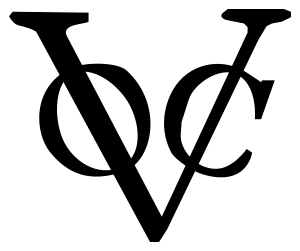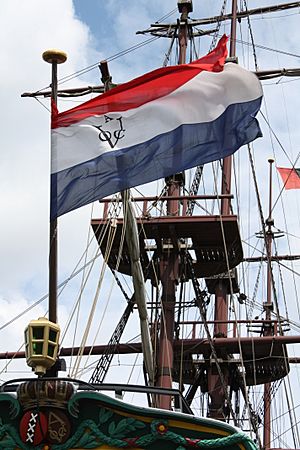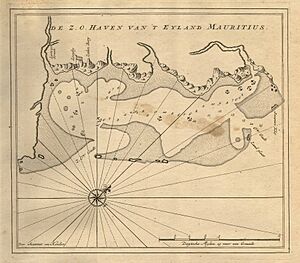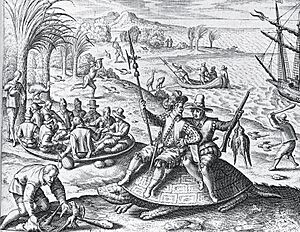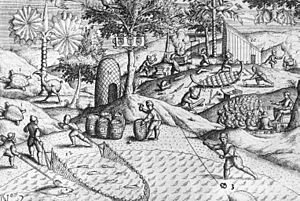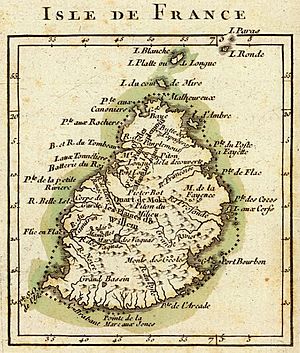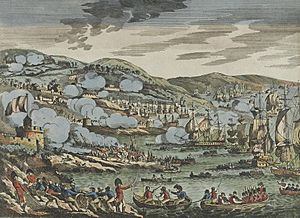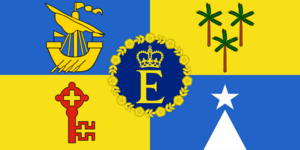History of Mauritius facts for kids
The history of Mauritius started with its possible discovery by people from Southeast Asia long ago. Later, Arabs knew about the island, and then Portuguese explorers found it in the early 1500s. Mauritius was then taken over by the Netherlands, France, and Great Britain. It finally became an independent country on March 12, 1968.
Contents
Discovery of the Island
Mauritius was first officially found by the Portuguese. We know this from old Portuguese maps. The oldest map showing the island is the Cantino Planisphere from 1502. This map shows three islands that are now called the Mascarenes (Réunion, Mauritius, and Rodrigues). The map called them Dina Margabin, Dina Arobi, and Dina Moraze.
Portuguese Explorers (1507–1513)
Portuguese explorers visited Mauritius again between 1507 and 1513. Mauritius and the islands around it became known as the Mascarene Islands. This name came from Pedro Mascarenhas, a Portuguese explorer.
An official world map by Diogo Ribeiro showed these islands. They were found by chance during an expedition led by Tristão da Cunha. His ships ran into a big storm and had to change course. One ship, the Cirne, saw Réunion island on February 9, 1507. They named it "Santa Apolonia." Mauritius was found during the same trip and was called "Cirne." Rodrigues was named "Diogo Rodrigues."
The Portuguese were not very interested in these islands. They already had bases in Asia and Africa. They preferred to use the Mozambique Channel to get to India. So, the Portuguese did not build any permanent settlements on Mauritius.
Dutch East India Company (1598–1710)
In 1598, Dutch ships led by Admiral Wybrandt van Warwyck arrived in Mauritius. They found a safe bay and named it "Port de Warwick." They named the island "Prins Mauritz van Nassaueiland" after Prince Maurits of the Netherlands. This is where the name Mauritius comes from.
Dutch ships then used Mauritius as a stopover on their long journeys. In 1606, Dutch sailors found a bay in the northwest of the island. They called it "Rade des Tortues" because they saw many tortoises there. This bay later became Port Louis.

Dutch colonization started in 1638. Cornelius Gooyer set up the first permanent Dutch settlement with 25 people. He became the first governor. Later, Adriaan van der Stel took over and began exporting valuable ebony wood. To do this work, people from Madagascar were brought to the island. Many of them escaped into the forests.
The Dutch faced many problems on the island. There were cyclones, droughts, pests, and not enough food. These difficulties made life very hard. In 1658, the Dutch decided to leave the island. Only a few people stayed behind.
A second attempt to colonize the island in 1664 also failed. From 1666 to 1669, Dirk Jansz Smient managed the colony, focusing on cutting ebony trees. Other governors tried to make the island an agricultural colony, but their plans did not work out.
Issac Johannes Lamotius became governor in 1677. He was later sent away for bad behavior. Roelof Diodati took over in 1692. He also faced many challenges like storms and diseases. In 1702, a pirate named John Bowen landed on the island. The Dutch governor had to sell them a ship so they would leave.
Finally, in 1710, the Dutch completely abandoned Mauritius.
The Dutch left some important things behind:
- They gave the island its name, Mauritius, and named many places like "Pieter Both" mountain.
- They brought sugar cane plants from Java to the island.
- Sadly, their presence led to the extinction of the local dodo bird and giant tortoises. This happened because the Dutch hunted them for food and brought new animals that harmed the native species.
- They cut down large areas of ancient forests for ebony wood.
French Rule (1715–1810)
After the Dutch left, the island became a French colony in 1715. Guillaume Dufresne d'Arsel claimed it for France and named it "Isle de France." The French officially started their occupation in 1721.
The island really began to grow in 1735 with the arrival of Governor Mahé de La Bourdonnais. He planted spices like pepper and cinnamon at the Jardin Pamplemousses.
Mahé de La Bourdonnais made Port Louis an important naval base and a place for building ships. Many buildings were constructed during his time, some of which are still standing today. People from India also arrived in Mauritius in 1729 to work as craftsmen.
The island was managed by the French East India Company until 1767. During French rule, many people were brought from Africa (like Mozambique, Madagascar, and Zanzibar) to work. Because of this, the island's population grew a lot, from 15,000 to 49,000 in 30 years. By the early 1800s, there were 60,000 workers on the island.
In 1806, Governor General Charles Mathieu Isidore Decaen created the city of Mahébourg, named after Mahé de La Bourdonnais.
During the Napoleonic wars, "Isle de France" became a base for French privateers. These were ships that attacked British trading ships. This continued until 1810, when the British sent a large force to capture the island. The British landed in the north of the island and quickly defeated the French. The French gave up on December 3, 1810.
In 1814, the Treaty of Paris (1814) officially gave "Isle de France" to Great Britain. The British renamed it "Mauritius" again. They also took Rodrigues and the Seychelles. The British promised to respect the languages, customs, and laws of the people living there.
British Rule (1810–1968)
British rule began with Robert Townsend Farquhar as governor. Many social and economic changes happened quickly. The French language was still used more than English.
An important change was the official end of slavery on February 1, 1835. The plantation owners received money for the people who had been working for them. After slavery ended, the British needed new workers for the sugar cane fields. So, they brought many people from India to work under a system called indentured labor. These workers arrived at places like the Aapravasi Ghat. This period changed the island's society, politics, and economy. Some of these workers also went to other places like the West Indies.
Indo-Mauritians are people whose families came from India. They arrived mostly between 1835 and 1924. The Franco-Mauritian elite, who were of French descent, owned most of the large sugar estates and controlled businesses. As the Indian population grew and more people could vote, political power slowly shifted from the Franco-Mauritians to the Indo-Mauritians.
In November 1901, Mahatma Gandhi visited Mauritius on his way from South Africa to India. He stayed for two weeks and encouraged the Indo-Mauritian community to get an education and be more involved in politics. He later sent a young lawyer, Manilal Doctor, to help the Indo-Mauritians.
The opening of the Suez Canal in 1869 meant fewer ships stopped in Mauritius. This hurt the island's economy.
Conflicts sometimes happened between the Indian community and the Franco-Mauritians in the 1920s. This led to the founding of the Mauritius Labour Party in 1936 by Maurice Curé. This party aimed to protect the interests of the workers.
During World War II, many Mauritians volunteered or were asked to serve as soldiers or workers. Some served in the Middle East and Southern Europe. In December 1943, some Mauritian soldiers in Madagascar refused to fight abroad because they had only signed up for service in Mauritius.
Mauritius was also an important base for gathering information and stopping Japanese submarines and German ships during the war. More than 1500 Jewish people from Central Europe were held in Beau Bassin from 1940 to 1945.
In August 1948, elections were held for a new Legislative Council. This was a big step towards self-rule for Mauritius. For the first time, women could vote and be elected. Many Indo-Mauritians and Creoles were elected to this council.
Independence (1968)
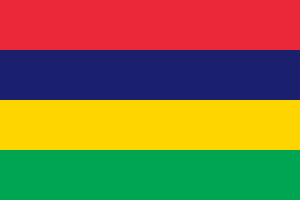
The campaign for independence grew stronger after 1961. The British agreed to give Mauritius more self-government and eventually full independence. A group of political parties, including the Mauritian Labour Party, won the 1967 election.
Sir Seewoosagur Ramgoolam, who was the Chief Minister, became the first prime minister after independence. Mauritius became independent on March 12, 1968. This date was chosen to match Mahatma Gandhi's Salt March in 1930. Before independence, there were some ethnic conflicts that led to about 300 deaths. British troops had to help control the situation.
British rule ended on March 12, 1968. The British Queen, Elizabeth II, remained the head of state as the Queen of Mauritius. Her duties were carried out by the Governor-General.
The ruling coalition of parties broke apart by 1969. New political parties like the Mouvement Militant Mauricien (MMM) emerged. Sir Seewoosagur Ramgoolam remained prime minister until 1982. In 1982, the MMM and another party won the elections, and Sir Anerood Jugnauth became prime minister. This coalition later split, and Sir Anerood Jugnauth formed a new party called the Mouvement Socialiste Mauricien (MSM), which became the ruling party.
In 1990, Sir Seewoosagur Ramgoolam's son, Navin Ramgoolam, became the leader of the Labour Party.
Republic (1992-present)
Mauritius became a republic within the Commonwealth on March 12, 1992. The last Governor General, Sir Veerasamy Ringadoo, became the first President of Mauritius. He was later replaced by Cassam Uteem in June 1992.
Dr. Navin Ramgoolam became prime minister in 1995. He replaced Sir Anerood Jugnauth, who had been prime minister for 13 years. In 2000, Sir Anerood Jugnauth's MSM party, working with Paul Bérenger's MMM, returned to power. Sir Anerood Jugnauth became prime minister again, but after three years, he retired and became president. Paul Bérenger then became prime minister.
In 2005, Dr. Navin Ramgoolam's party won the elections, and he became prime minister again. Sir Anerood Jugnauth remained president. In 2010, Dr. Navin Ramgoolam continued as prime minister after another election victory. Later, Kailash Purryag became president.
In 2014, Sir Anerood Jugnauth became Prime Minister again. In 2016, Mrs. Ameena Gureeb Fakim became the first female president of Mauritius. She later resigned in March 2018.
In January 2017, Prime Minister Anerood Jugnauth stepped down and gave power to his son, Pravind Kumar Jugnauth. In November 2019, Pravind Kumar Jugnauth's party won the elections, and he started a new five-year term as prime minister.
On July 25, 2020, a Japanese ship called MV Wakashio ran aground off the coast of Mauritius. It leaked a lot of oil into the ocean, causing a very serious environmental disaster. This area is home to delicate marine life.
On December 5, 2022, another ship, Yu Feng 67, ran aground on the reefs of St. Brandon. It was carrying diesel and other oils. This was the fourth shipwreck involving a Taiwanese vessel in Mauritius in 2022.
See also
- History of Africa
- History of Southern Africa
- Politics of Mauritius
- List of prime ministers of Mauritius
- Governor of Mauritius (disambiguation)
- Port Louis history and timeline
Images for kids



